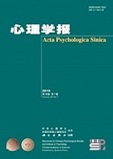|
|
Subliminal Affective Priming Effect by Faces With Different Valence: An ERP Study
LU Yong,ZHANG Wei-Na,SHEN De-Li
2010, 42 (09):
929-938.
Subliminal affective priming refers to a phenomenon where subliminal presentation of a prime object shifts subsequent affective evaluation of the supraliminal object in the affective direction of the prime object, but the neural mechanisms underlying this effect is unclear. The emotional significance and neural specificity of facial processing make faces an ideal prime for automatic processing. But the emotional faces differ in two affective dimensions: valence (unpleasant-to-pleasant) and arousal (low-to-high). They may have different effects on ERP component. Most previous studies used only two or three kinds of emotional faces to study subliminal affective priming. In this study, the dimension of arousal was controlled and two groups of priming faces (unpleasant vs. pleasant) were presented for 20ms, followed by a mosaic neutral face for 800ms. We combined behavioral analyses of subliminal affective priming with recordings of event-related potential (ERP) that provide on-line measurements of neural processing with high temporal resolution. We hypothesized that positive and negative prime faces led to valance-consistent biases in affective judgments of ambiguous neutral faces. We reasoned that P1, N1, P2, N2, P3, and late positive potentials (LPP) could provide evidence on early perceptual processing, attention orienting, and late elaborate processing.
Seventeen volunteers from University took part in this experiment, they were instructed to judge the affect of the neutral target faces as unpleasant or pleasant, while the response speed was not stressed. The EEG was recorded from 64 scalp sites using Ag/AgCl electrodes. Signals were averaged offline for 1000 ms with an additional 200 ms recorded prior to prime onset to allow for baseline correction. The ERP were averaged separately for unpleasant and pleasant trials. Peak amplitude values were computed for 70-130ms (N1); 190-240ms (N2); 400-800ms (LPP) time intervals, time locked to prime onset (time 0), these ERP measures were obtained from six electrodes: F5, FZ, F6, C3, CZ, C4. We also computed peak amplitudes from intervals of 70-130ms, 130-190ms, 240-400ms, 400-800ms, corresponding to P1, P2, P3 and LPP. These ERP measures were obtained from eight electrodes: P3, PZ, P4, PO7, POZ, PO8, O1, O2. A repeated measures ANOVA on the peak amplitude of each component was conducted. In addition, the standardized low-resolution brain electromagnetic tomography (sLORETA) technique was conducted to estimate the neural sources of these ERP components which are sensitive to subliminal affective priming.
We found that unpleasant and pleasant prime faces led to valence-consistent biases in participants’ affective judgments of neutral target faces. ERP results showed that subliminal primes differentially influenced anterior N1 and posterior P2 potentials, with larger amplitudes in negative priming trials. Source analysis revealed that N1 might be generated from brain regions near the precuneus, while P2 was localized to the superior temporal gyrus.
These results confirm our hypothesis that the subliminal affective priming effect is related to prime valence, suggesting that the early perceptual analysis of targets is affected by subliminal affective information. The results demonstrate the subliminal affective priming effect.
Related Articles |
Metrics
|




